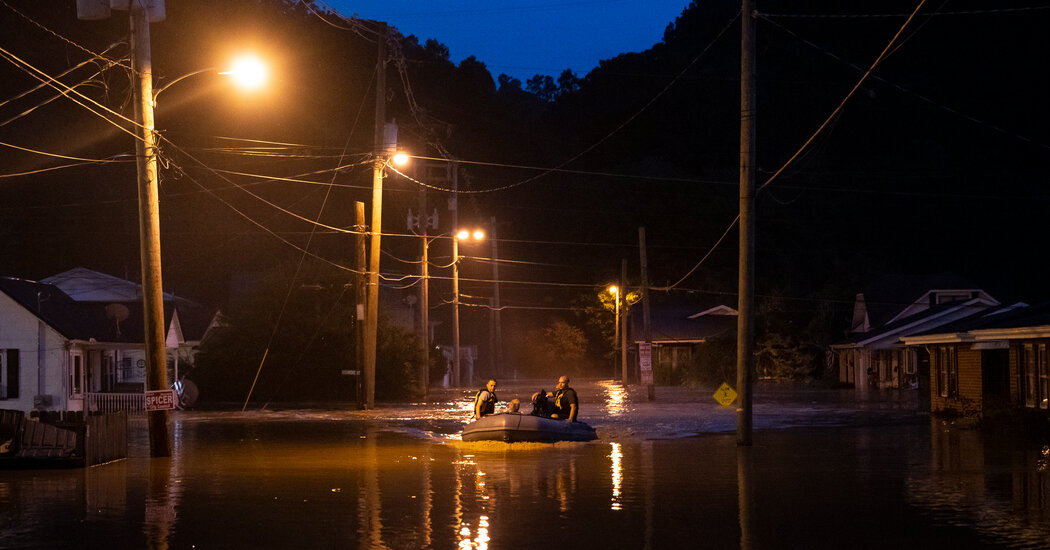WASHINGTON — The rising toll of climate change across the United States has been measured in lives lost, buildings destroyed and dollars spent on recovery. But a report released on Wednesday uses a different measure: Which parts of the country have suffered the greatest number of federally declared disasters?
That designation is reserved for disasters so severe, they overwhelm the ability of state and local officials to respond. The report finds that disasters like these have become alarmingly common.
From 2011 to the end of last year, 90 percent of U.S. counties have experienced a flood, hurricane, wildfire or other calamity serious enough to receive a federal disaster declaration, according to the report, and more than 700 counties suffered five or more such disasters. During that same period, 29 states had, on average, at least one federally declared disaster a year somewhere within their borders. Five states have experienced at least 20 disasters since 2011.
The numbers exclude disaster declarations related to the coronavirus pandemic.
“Climate change is here,” said Amy Chester, the managing director of Rebuild by Design, a nonprofit that helps communities recover from disasters, and which prepared the report. “Every single taxpayer is paying for climate change.”
That doesn’t mean climate change is hitting every part of the country to the same degree. Wealthy and populous cities are often better able to sustain the shock of extreme weather events. By focusing on federally declared disasters, the report is able to equalize those differences, offering something close to a true accounting of which places are most exposed to climate shocks they cannot cope with on their own.
At the top of that list are five counties that have each experienced, on average, more than a disaster a year since 2011. Those counties are concentrated in two areas: Southern Louisiana (where counties are called parishes) and eastern Kentucky.
Read More About Extreme Weather
Louisiana outpaces the rest of the United States in another regard. Over the past decade, the state has received more federal disaster money per capita — $1,736 for each resident — than anywhere else in the nation, the report found. Only New York State comes close, at $1,348.
But the burden of climate shocks extends beyond the Gulf Coast and Appalachia. Since 2011, California has received 25 federal disaster declarations, including for wildfires in 2017 and 2018 that resulted in $2.5 billion in federal money to rebuild public infrastructure. Mississippi and Oklahoma have each suffered 22 disasters. Iowa has had 21, mostly for severe storms and flooding.
Even in states not typically associated with extreme weather, some counties have had frequent calamities. Fairfield County, Conn., which includes Greenwich and Stamford, has received eight federal disaster declarations since 2011. Grafton County, in central New Hampshire, has had seven. Morris County, N.J., 30 miles west of Manhattan, has had nine.
Not every type of disaster is associated with climate change. For example, it’s unclear whether there is a link between rising temperatures and earthquakes. But scientists have become increasingly convinced that a warming world is contributing to worsening floods, hurricanes, wildfires and other extreme weather events.
The data also shows the areas least exposed to unmanageable climate shocks, at least so far. States in the Midwest, including Illinois, Indiana, Ohio and Michigan, are among those with the smallest number of federal disaster declarations, with an average of roughly one disaster every two years.
But the authors of the report say that just because a state has had fewer federal disaster declarations doesn’t mean it has gotten through the past decade largely unscathed.
At the bottom of the list is Nevada, which has had just three federal disaster declarations since 2011. Next door, Arizona has had just six. Yet, Nevada and Arizona ranked highest for heat-related deaths from 2018 to 2021, according to the report.
“Heat has the highest mortality of all climate impacts, but their disaster declarations were so low,” Ms. Chester said. The reason: Federal disaster declarations focus on property damage more than direct human consequences like illness, injury or death.
Still, the prevalence of federally declared disasters remains one tool for gauging the effects of climate change.
The report shows the importance of doing more to increase community resilience, said Victoria Salinas, the acting deputy administrator for resilience at the Federal Emergency Management Agency. “By better understanding risk,” she said, “we can more effectively take action together to accelerate resilience and adaptation in our nation’s most at-risk and disadvantaged communities.”
To pay for that new spending, Rebuild by Design proposes, states should impose a 2 percent surcharge on insurance premiums.
The American Property Casualty Insurance Association, which represents insurers, rejected the proposal, saying it could make insurance less affordable and potentially lead some people to not carry enough coverage to recover from disasters. Adding a surcharge to insurance policies “is the wrong approach,” Don Griffin, a vice president at the association, said in a statement.
Using an insurance surtax to pay for disasters is a strategy that is already in use, in a sense. As the report notes, Florida levies surcharges on private insurance policies to make up for shortfalls in its state-run insurance program — something that’s likely to happen in the aftermath of Hurricane Ian.
Rebuild by Design suggests reversing the chronology. Rather than taxing insurance payments to pay for disaster recovery, a state would come up with additional funds before a storm, then use that money to better prepare communities before a disaster strikes, perhaps making it unnecessary for the federal government to declare a disaster at all.

Tinggalkan Balasan